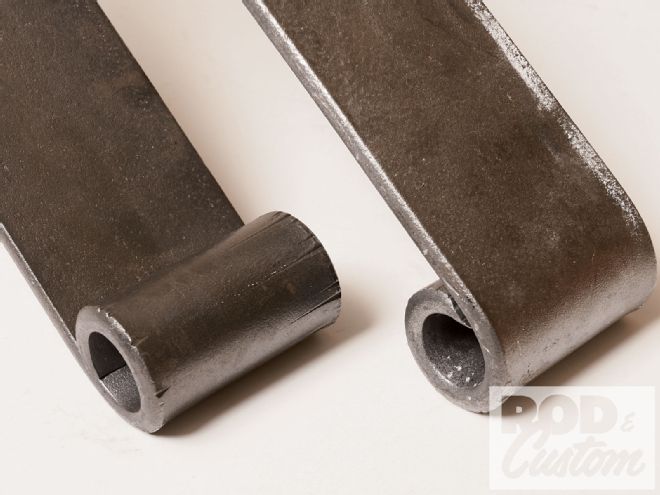
The practice of reversing a spring's eyes is one of the most traditional modifications going. If you don't know, spring eyes are the loops at the ends of a leaf spring. They attach to either the chassis or axle by way of shackles or bolts in bushings pressed into them. As they dictate the location of the chassis in relationship to the axle, moving the eyes from one face of the leaf spring to the other-say from the bottom to the top-alters a vehicle's ride height. That their affect on ride height is plainly visible, and the modification is seemingly simple, means that reversing the eyes on an existing spring has been the first line of attack to lower hot rods and custom cars alike for decades.
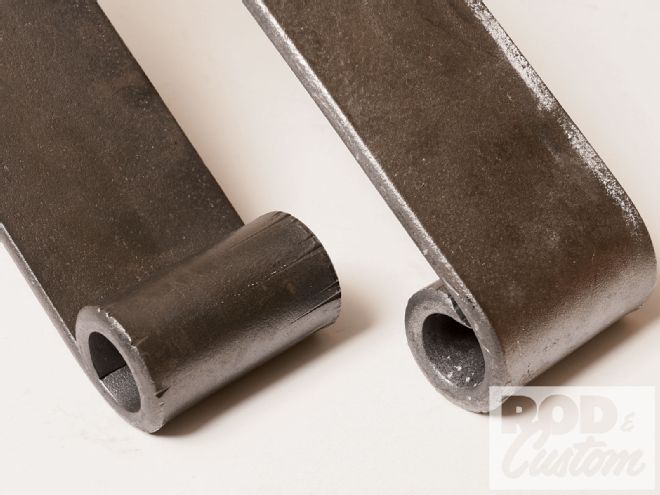 The subject at hand are the "loops" or eyes, at the ends of a leaf spring's main plate. Along with the plate's width, thickness, and length, they determine the chassis' ride height.
The subject at hand are the "loops" or eyes, at the ends of a leaf spring's main plate. Along with the plate's width, thickness, and length, they determine the chassis' ride height.
Knowing all that gibberish, imagine my surprise when a local (and very reputable) spring shop refused to reverse the eyes on my roadster's rear spring. The owner admitted that he once reversed the spring eyes on every hot rod in the area, and in fact had done so for decades. "But not anymore," he says. The fact that he wouldn't explain why he'd rather make a new main plate-main leaf to you and me-rather than modify mine raised a red flag. Suspecting that I was being taken for a ride, I called Mike Eaton at Eaton Detroit Spring, for a second opinion.
The local shopkeeper's credibility may have been at stake but Eaton's isn't. For more than 70 years the factory that bears his family's name has made springs for auto manufacturers and individuals alike. He grew up on the shop floor, which means he knows springs probably better than he knows himself. In other words, I trust his knowledge. "No, we don't reverse spring eyes, either," he affirms.
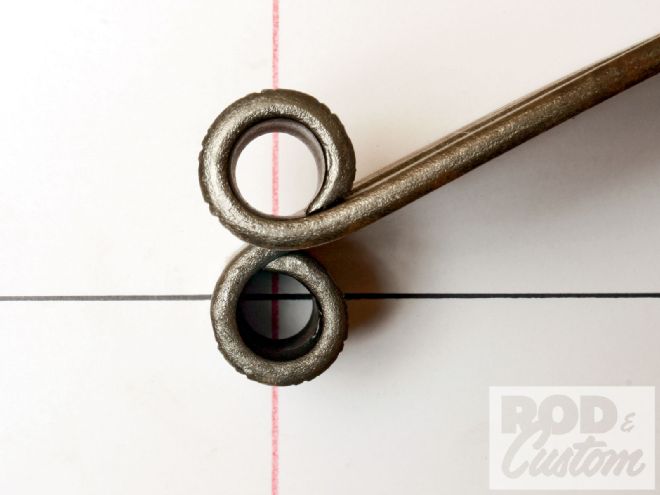 Moving the eye absolutely vertically from one side of the main plate to the other will alter the spring's free height, or distance from the spring eyes' centerline to the center of the arch. Theoretically it's so simple.
Moving the eye absolutely vertically from one side of the main plate to the other will alter the spring's free height, or distance from the spring eyes' centerline to the center of the arch. Theoretically it's so simple.
Only unlike the local shopkeeper, Eaton carefully laid out why it's not technically correct to alter an existing spring. His primary reason is cost-and it's in our favor, believe it or not.
As he explained, a spring's shape is only the first part of its construction process. A spring acquires a memory of its shape during the final heat-treat process. Though it's possible to reverse a spring's eyes at room temperature, it's temporary at best. "A spring will always try to go back to its original shape," he reveals. The spring won't fully achieve its original shape, nor will it retain the modified shape. In other words, the vehicle will sag in relatively short order.
"The only way to re-shape a spring is to heat treat it," he continues. Only the process to prepare an existing main plate for heat treatment-disassembly, sandblasting, inspection, annealing, re-shaping, etc.-costs far more than the strip of spring steel that makes a new main plate. In fact, to re-shape an existing main plate can cost twice as much as a brand-new one made from virgin materials. "And springs don't last forever," he reminds us. "They're made of metal and metal fatigues."
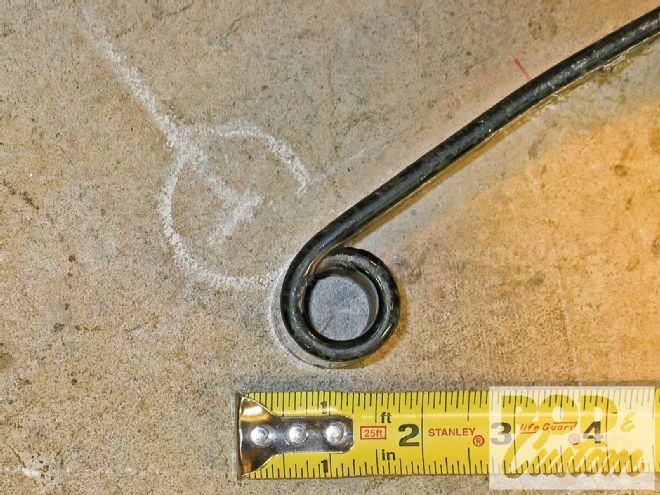 But moving a spring eye absolutely vertically isn't so simple in practice. A friend scribed the plate's arch and spring eye centerlines on the ground before he inverted it. Modifying the plate for standard eyes reduced the distance between the spring eyes even though the spring has the same profile as before.
But moving a spring eye absolutely vertically isn't so simple in practice. A friend scribed the plate's arch and spring eye centerlines on the ground before he inverted it. Modifying the plate for standard eyes reduced the distance between the spring eyes even though the spring has the same profile as before.
As I found out by my own experiments, there's also the issue of geometry. A spring must maintain a certain relationship with its shackle(s) to work properly. Rather than labor things by explaining the various shackle mounting variations, let's just say that auto manufacturers make a spring a certain length and mount them in such a way that the shackles operate at a favorable angle.
As explained by the following, altering an existing main plate to relocate the eyes almost always changes the distance between the eyes. Arbitrary changes made to the distance between the spring eyes invariably alters a spring's effectiveness and/or disrupts a vehicle's stability.
My particular case is atypical, as I wanted my spring's main plate to have standard eyes instead of reversed eyes. Not understanding the dynamics or the heat-treating part, I had a friend invert the arch on my spring's main plate. Though he copied the arch to a tee and the spring was almost 3/4-inch taller than it was when it had reversed eyes, something curious happened: the spring eyes were closer together by nearly 2 inches!
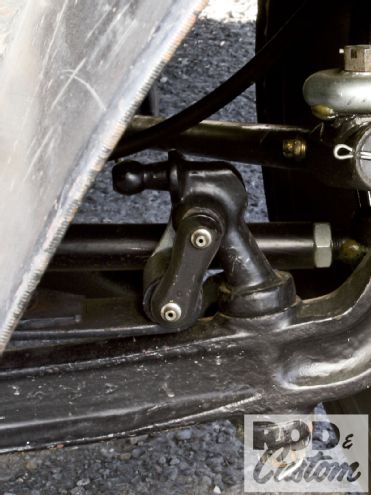 This revelation explained why stock springs magically "grow" when their eyes are reversed. For reference, the shackles on a Ford transverse leaf spring should sit at about a 45-degree angle. That these are around 25 indicates that the spring is too long. The principles that caused this are the same as what "shrunk" my spring, only in reverse.
This revelation explained why stock springs magically "grow" when their eyes are reversed. For reference, the shackles on a Ford transverse leaf spring should sit at about a 45-degree angle. That these are around 25 indicates that the spring is too long. The principles that caused this are the same as what "shrunk" my spring, only in reverse.
The process of spreading the spring the additional amount to fit on my car pretty much flattened the spring an inch lower than it was before I reversed it. Even more disheartening, the spring load was intense. I could hardly compress the suspension by standing on a framehorn. That the shackles pointed toward each other and not at their 45-degree angle meant that the spring was way too short. The car sat lower than before and would've ridden like a buckboard. The solution, it seemed, was to lengthen the main plate to correct the geometry.
I'm capable of many things but making a spring isn't one of them. That's when I called Eaton-and it was a good thing I did, as he explained the heat treatment, another thing I couldn't overcome. His shop made a new main plate with standard eyes and the correct (longer) bit longer to compensate for the dimensional change that results from moving the spring eyes from one side of the plate to the other.
The result of the new plate's shape means my roadster sits better now. And due to the proper forming and heat-treating techniques, it promises to stay that way for a long time to come.